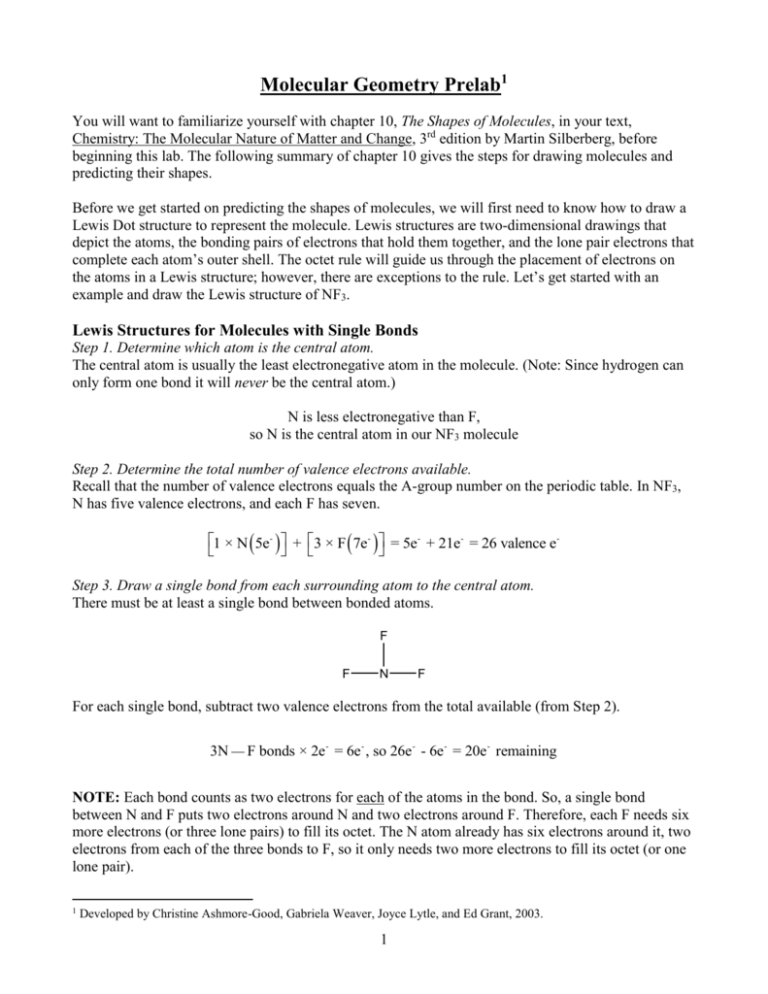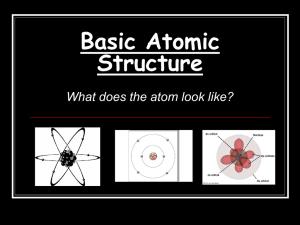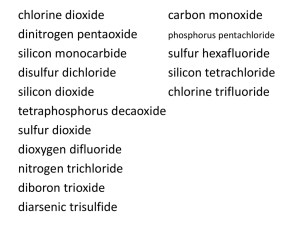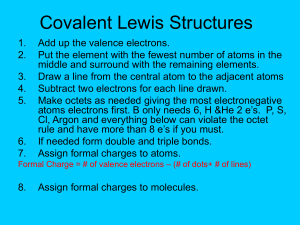summary of chapter 10
advertisement

Molecular Geometry Prelab1 You will want to familiarize yourself with chapter 10, The Shapes of Molecules, in your text, Chemistry: The Molecular Nature of Matter and Change, 3rd edition by Martin Silberberg, before beginning this lab. The following summary of chapter 10 gives the steps for drawing molecules and predicting their shapes. Before we get started on predicting the shapes of molecules, we will first need to know how to draw a Lewis Dot structure to represent the molecule. Lewis structures are two-dimensional drawings that depict the atoms, the bonding pairs of electrons that hold them together, and the lone pair electrons that complete each atom’s outer shell. The octet rule will guide us through the placement of electrons on the atoms in a Lewis structure; however, there are exceptions to the rule. Let’s get started with an example and draw the Lewis structure of NF3. Lewis Structures for Molecules with Single Bonds Step 1. Determine which atom is the central atom. The central atom is usually the least electronegative atom in the molecule. (Note: Since hydrogen can only form one bond it will never be the central atom.) N is less electronegative than F, so N is the central atom in our NF3 molecule Step 2. Determine the total number of valence electrons available. Recall that the number of valence electrons equals the A-group number on the periodic table. In NF3, N has five valence electrons, and each F has seven. 1 × N 5e- + 3 × F 7e- = 5e- + 21e- = 26 valence e Step 3. Draw a single bond from each surrounding atom to the central atom. There must be at least a single bond between bonded atoms. F F N F For each single bond, subtract two valence electrons from the total available (from Step 2). 3N F bonds × 2e- = 6e- , so 26e - - 6e - = 20e - remaining NOTE: Each bond counts as two electrons for each of the atoms in the bond. So, a single bond between N and F puts two electrons around N and two electrons around F. Therefore, each F needs six more electrons (or three lone pairs) to fill its octet. The N atom already has six electrons around it, two electrons from each of the three bonds to F, so it only needs two more electrons to fill its octet (or one lone pair). 1 Developed by Christine Ashmore-Good, Gabriela Weaver, Joyce Lytle, and Ed Grant, 2003. 1 Step 4. Distribute the remaining valence electrons in pairs to fill each atom’s octet. First place lone pair electrons around the surrounding atoms. (Remember, hydrogen will form only one bond and will not have any lone pair electrons around it.) If any electrons remain, place them around the central atom. Then check that each atom has 8e - . F F N F This is the Lewis structure for NF3. It’s always a good idea to double check that the number of electrons in your Lewis structure equals the sum of the valence electrons calculated in Step 2. (Remember, there are two electrons in every bond.) 3 × bonds 2e- + 10 × lone pairs 2e- = 6e- + 20e- = 26e Lewis Structures for Molecules with Multiple Bonds In some cases, you will find that after completing steps 1 through 4, there are not enough electrons for the central atom to follow the octet rule. This usually means that a multiple bond is present and the following additional step is needed: Step 5. Complete central atom octets with multiple bonds. If, after Step 4, the central atom still does not have an octet, bring in a lone pair of electrons from one of the surrounding atoms to form an additional bond with the central atom. Repeat Step 5 until the central atom has an octet. For example, let’s draw the Lewis structure of N2. Step 1. Determine which atom is the central atom. there are only two atoms, so there is no “true” central atom Step 2. Determine the total number of valence electrons available. 2 × N 5e- = 10 valence e- Step 3. Draw a single bond from each surrounding atom to the central atom. N 1N N N bond × 2e- = 2e- , so 10e- - 2e - = 8e - remaining 2 Step 4. Distribute the remaining valence electrons in pairs to fill each atom’s octet. N N 1 × bonds 2e- + 4 × lone pairs 2e- = 2e- + 8e- = 10e We’ve used all 10 valence electrons, but we don’t have an octet around both atoms, so we’re going to have to go on to Step 5. Step 5. Complete central atom octets with multiple bonds. N N To give both atoms an octet, we had to bring in two lone pairs of electrons to form the triple bond that exists in N2. It would also be a good idea to recount the electrons and make sure we didn’t accidentally lose any electrons. 3 × bonds 2e- + 2 × lone pairs 2e- = 6e- + 4e - = 10e Formal Charge: Selecting the Best Lewis Structure Sometimes there is more than one way to draw a Lewis Structure such that the octet rule is satisfied. In this case, it is necessary to choose between the possible structures. We use formal charges to select the best structure for a compound. An atom’s formal charge is its total number of atomic valence electrons minus the number of valence electrons it “owns” in the molecule: it owns all of its unshared valence electrons and half of its shared valence electrons (shared valence electrons are the electrons in a bond). Thus, Formal charge on the specified atom = no. of valence e - no. of unshared valence e - 12 no. of shared valence e - - - Note that the formal charges must sum to the actual charge on the species: zero for a neutral molecule or the ionic charge for an ion. There are three criteria to follow when trying to decide which is the “correct” Lewis structure: Smaller absolute value of formal charges is preferable to larger ones. Like charges on adjacent atoms are not desirable. A more negative formal charge usually resides on a more electronegative atom. Let’s draw the Lewis structure for the N2O molecule. Step 1. Determine which atom is the central atom. N is less electronegative than O, so N is the central atom 3 Step 2. Determine the total number of valence electrons available. 2 × N 5e- + 1 × O 6e- = 10e- + 6e- = 16e Step 3. Draw a single bond from each surrounding atom to the central atom. N 1N N bond × 2e- + 1N N O O bond × 2e- = 4e- , so there are 12e- remaining Step 4. Distribute the remaining valence electrons in pairs to fill each atom’s octet. N N O 2 × bonds 2e- + 6 × lone pairs 2e- = 4e - + 12e- = 16e We’ve used all the valence electrons, but still don’t have an octet around the central N atom, so we’re going to have to go to Step 5 and form multiple bonds. Step 5. Complete central atom octets with multiple bonds. In this particular case there are several different ways that we can complete octets for each of the atoms by bringing in different sets of lone pairs and forming different types of multiple bonds. N N N O N O N N O Each of these Lewis structures for this molecule is acceptable; however, we need to determine which is the “best” Lewis structure for N2O and we can do that by calculating the formal charges throughout the molecule. To make it easier to keep track of the two different N atoms, let’s label them NA and NB. Then we will use our formula to calculate the formal charges on each of the atoms. Formal charge on the specified atom = no. of valence e - no. of unshared valence e - 12 no. of shared valence e - NA NB O - NA NB O - NA NB O 1 N A 5 - 2 - 6 = 0 2 1 N B 5 - 0 - 8 = +1 2 1 N A 5 - 4 - 4 = -1 2 1 N B 5 - 0 - 8 = +1 2 1 N A 5 - 6 - 2 = -2 2 1 N B 5 - 0 - 8 = +1 2 1 O 6 - 6 - 2 = -1 2 1 O 6 - 4 - 4 = 0 2 1 O 6 - 2 - 6 = +1 2 4 Let’s redraw our three possible Lewis structures with their assigned formal charges. (0) (+1) (-1) (-1) N N O N I (+1) N (0) (-2) O N (+1) (+1) N O III II We can throw out structure III because it has the larger formal charges as well as having like charges on adjacent atoms (both NB and O have a +1 formal charge). Structures I and II have the same formal charges, but structure I has the negative formal charge on the more electronegative atom. Therefore, the “best” Lewis structure for N2O is: (0) (+1) (-1) N N O I Lewis Structures for Exceptions to the Octet Rule The octet rule is a useful guide for most simple molecules with Period 2 central atoms, but it does not hold for every one. Also, many molecules have central atoms from higher periods. Some molecules have fewer than eight electrons around the central atom, and others have more. This lab will introduce two types of octet rule exceptions, first will be electron-deficient molecules and second will be molecules with expanded valence shells. Electron-Deficient Molecules Gaseous compounds containing either beryllium or boron as the central atom are often electron-deficient. These compounds have fewer than eight electrons around the Be or B atom. Beryllium, with only two valence electrons, will only form two bonds and will therefore, have only a quartet of electrons around it. Boron, with only three valence electrons, will form three bonds and have only a sextet around it. Expanded Valence Shells Many molecules and ions have more than eight valence electrons around the central atom. An atom expands its valence shell to form more bonds, a process that releases energy. The only way to accommodate additional pairs of electrons is for the central atom to use its empty outer d orbitals in addition to its occupied s and p orbitals. Therefore, expanded octets occur around a central nonmetal from Period 3 or higher, those in which d orbitals are available. Let’s take a look at the Lewis structure for the sulfate ion, SO42-. After following Steps 1 through 4 and assigning formal charges, we find that the Lewis structure for SO42- looks like: (-1) O (-1) O (+2) S O (-1) O (-1) However, because sulfur is a Period 3 element, it has empty d orbitals that it can use to expand its octet and decrease the formal charges throughout the ion. 5 (-1) O (-1) O S O O This is a better Lewis structure for the SO42‾ ion because it has fewer formal charges. Sulfur could expand its octet even further by bringing in two more pairs of electrons from the other two oxygen atoms, however, that would result in a formal charge of -2 on the sulfur which is less electronegative than oxygen and so less likely to carry the negative charge. While this further expanded octet on sulfur would result in a possible Lewis structure for the sulfate ion, it is not the best Lewis structure. Now that we can draw Lewis structures for molecules and ions, let’s figure out how to predict their shapes. Electron-Group Arrangements and Molecular Shapes The number of regions of high electron density, or VSEPR number, is the number of electron pairs surrounding the central atom; this includes lone pair electrons and bonding electrons. Each lone pair of electrons counts as one region of high electron density. Each bonding pair counts as one region of high electron density. However, multiple bonds count the same as a single bond and contribute only one region of high electron density. (Note: The number of regions of high electron density and VSEPR number refer to the same thing and are used interchangeably.) Let’s find the VSEPR number for the central atom in each of the compounds for which we drew Lewis Structures earlier. (-1) O F F N F (0) (+1) (-1) N N O I (-1) O S O O # of lone pairs 1 0 0 # of bonding pairs 3 2 4 VSEPR # 4 2 4 The name for the arrangement of the electrons around the central atom is based on the number of regions of high electron density (or VSEPR number) and is called the “electron-group arrangement”. This comes from the fact that it includes all electrons, both bonding and nonbonding in the name. The “molecular shape” describes the relative positions of the atomic nuclei. In other words, it includes only the bonded atoms and not the lone pair electrons when describing the shape of the compound. Throughout this assignment, you are required to give both the electron-group arrangements and molecular shapes for several molecules and ions. 6 Bond Angles The ideal bond angles for each of the electronic arrangements are given below. When only one angle is given, the others are the same magnitude. It may be helpful to look at these shapes on the website and identify the angles shown below. Linear VSEPR # = 2 trigonal planar VSEPR # = 3 trigonal bipyramidal* VSEPR # = 5 tetrahedral VSEPR # = 4 octahedral* VSEPR # = 6 *Don’t forget about the 180 angles that are also present in the trigonal bipyramidal and octahedral shapes. The bond angles shown above are known as ideal bond angles, because they are shown occurring in compounds that have identical bonds throughout the structure. Bond angles can be affected by the presence of lone pairs and multiple bonds in the compound. Lone pair electrons, which are not being shared between two atoms and therefore able to move more freely, and multiple bonds have a greater electron density. This greater electron density repels other electron dense regions to a stronger degree and thus increases the angle between it and a neighboring bond. Let’s take a look at ammonia, NH3. After following the steps for drawing the Lewis Structure of NH3, we find that it looks like: H N H H Ammonia has a VSEPR # of 4, which means the electronic arrangement is tetrahedral. The ideal bond angles in a tetrahedral configuration are 109.5. However, the lone pair on the nitrogen causes the H—N bonds to be squeezed closer together which gives a smaller H—N—H bond angle, as shown below. 7 Without experimental data to reveal the actual bond angles present in a compound, we show that we understand the effect of the lone pair by reporting the bond angles as being less than or greater than the ideal bond angle. For example, if we didn’t know the H—N—H bond angles in NH3 are equal to 107.3, we could draw the Lewis Structure and represent the H—N—H bond angles as being less than the ideal 109.5, as shown below. H N H <109.5o H Check Yourself It may be helpful to check your understanding of Lewis Dot Structures and Molecular Geometry by completing the prelab assignment that is posted on the internet. You can check your answers before going on to the lab assignment that is also posted on the internet. 8







